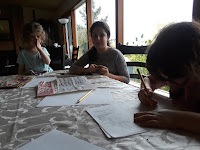| 11And he arrived at the place and lodged there because the sun had set, and he took some of the stones of the place and placed [them] at his head, and he lay down in that place. | יאוַיִּפְגַּ֨ע בַּמָּק֜וֹם וַיָּ֤לֶן שָׁם֙ כִּי־בָ֣א הַשֶּׁ֔מֶשׁ וַיִּקַּח֙ מֵֽאַבְנֵ֣י הַמָּק֔וֹם וַיָּ֖שֶׂם מְרַֽאֲשֹׁתָ֑יו וַיִּשְׁכַּ֖ב בַּמָּק֥וֹם הַהֽוּא: |
Recently Cohava was whining about her pillow being uncomfortable and I wondered was Yaakov the last person to say, "I'm tired! Where can I find a good rock pillow?" A little research revealed that hard pillows, made from rock, stone, or ceramics were the only options in the ancient world. Eventually the Romans and Greeks 'invented' soft pillows, although their purpose was for knees while kneeling and under the head of deceased, not for a good night sleep.
Why were soft pillows not a logical choice? There were furs and wool readily available in the ancient world, not to mention leaves and pine needles (recommended for making a bed in various outdoorsy classes).
In antiquity, pillows were not for a cozy night's sleep. Pillows served two purposes, to keep insects away from one's face and as a status symbol. Yaakov did not let his position of being on the run, with no possessions of physical worth stop him from realizing his holy status in service of Hashem. He collected the rocks as a pillow as a symbol of his connection to greatness (and to keep roaches off his face-eewww).
 For our project we decided to felt rocks. This was a project I wanted to try five years ago on Ki Tavo, but I didn't have any wool. This year Ruti got a present for her birthday which uses wool to make a stuffie. Theoretically it was a great gift. It has only one star reviews on Amazon, as people wrote that it deteriorated instantly and their children were heartbroken. I commented then that if it failed, we would use the wool to felt rocks.
For our project we decided to felt rocks. This was a project I wanted to try five years ago on Ki Tavo, but I didn't have any wool. This year Ruti got a present for her birthday which uses wool to make a stuffie. Theoretically it was a great gift. It has only one star reviews on Amazon, as people wrote that it deteriorated instantly and their children were heartbroken. I commented then that if it failed, we would use the wool to felt rocks.It survived for almost 6 weeks!
Honestly, the felting of rocks didn't go much better.
First the girls collected rocks from the garden. Then the fluffed the wool from the deceased stuffie.
Then we wrapped a rock in the wool, wrapped the woolen rock in tulle, and agitated in warm, soapy water.


The wool was enough for 9 rocks, so Ruti found 3 painted rocks (a different birthday present of hers) and declared them an improvement on the 12 rocks Yaakov arranged for himself.
The girls also enjoyed constructing Yaakov's ladder from a variety of toys.















































